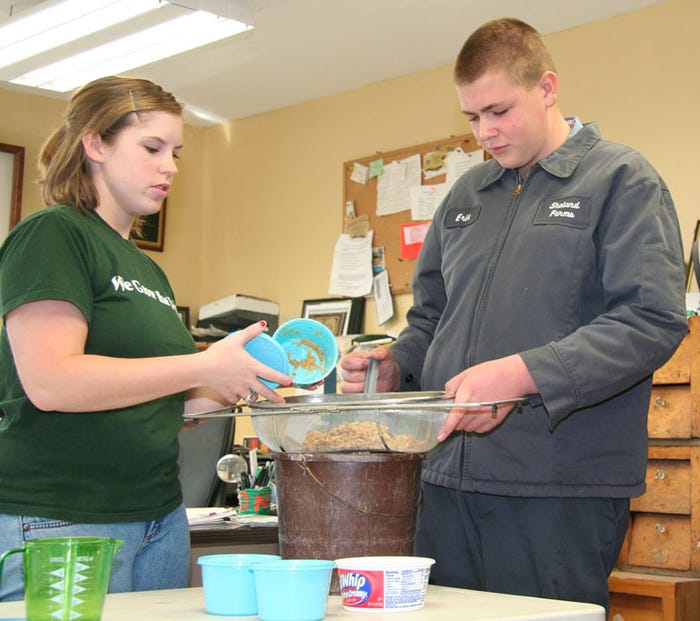
When it comes to biocontrol nematodes — those critters that reproduce by invading alfalfa snout beetle larvae, wire worms and other bugs — water, and lots of it, is key to getting them onto fields to reproduce.
And since these microscopic nematodes are sensitive to UV light, they must be applied at night.
But researchers think they have another, even better way — albeit dirtier — of applying them to fields: manure.
“The beauty of the manure application, all you have to do is dump the cup,” says Elson Shields, professor of entomology at Cornell University. Shields has led research on biocontrol nematodes for alfalfa snout beetle control for more than 20 years.
Thousands of acres in New York have been inoculated with biocontrol nematodes for control of alfalfa snout beetles. But researchers with the Northern New York Agricultural Development Program have been looking at applying nematodes in manure since at least 2016.
 REARING NEMATODES: Cornell University student Allyson Brimmer-Jones and Belleville-Henderson FFA student Erik Shelmidine strain nematodes at Sheland Farms. Students are helping to pilot test the biocontrol nematode-rearing protocol developed by Cornell University research technician Antonio Testa.
REARING NEMATODES: Cornell University student Allyson Brimmer-Jones and Belleville-Henderson FFA student Erik Shelmidine strain nematodes at Sheland Farms. Students are helping to pilot test the biocontrol nematode-rearing protocol developed by Cornell University research technician Antonio Testa.

The reason? Farmers want a simpler, more cost-effective way to apply them.
In 2016, initial research was done in a small field trial in Jefferson County, where the nematodes were held in manure for 15, 30 and 45 minutes prior to application. Soil samples were taken weeks later to see if the nematodes established.
That research showed that the nematodes could survive being held in manure, but only for 30 minutes or less.
Research expanded
In 2018, the project expanded to include six different farms. Researchers dumped varying amounts of cups of nematodes — 3 to 12 cups per acre — into the manure and the nematodes were held between 4 and 22 minutes.
They came back a couple of months later to take core samples to see if the nematodes established. Depending on the species — three different species were looked at — there was at least some nematode establishment in the fields.
The research continued in 2019. This time, the number of cups per acre were lowered — 1.75 cups to 4.8 cups per acre — and the amount of time in the manure was lowered — 5 to 19 minutes.
Core samples were taken after a few months and just as the year before, nematode establishment was found, but the number of cups per acre didn’t affect the results. This is important considering the average application cost is $25 per cup. A 7,300-gallon manure tanker can treat around 1 acre, so costs can add up quickly.
Each cup contains millions of nematodes that feed off a host bug, mainly wax worms or other type of larvae. When applied to soil they can last for many years. In a 10-year study in New York on a field with alfalfa-corn rotation, Shields says that nematode levels for the entire time stayed about the same.
“They’re a pretty broad predator,” he says.
Mike Hunter, a field crops specialist with Cornell Cooperative Extension, says they found no difference in establishment when looking at storage structures or other technical factors.
“We used different application equipment. Some of these tanks had circulation pumps. We didn’t find any differences,” he says.
Manure was spread in different fields, including on grass and corn stubble.
“We were pleasantly surprised that we didn’t see any differences,” he says. “We were certainly skeptical of how we were going to put them in that environment and have them survive, just because of the environment in there; it’s not clear water.”
Biocontrol nematodes have been shown to effectively control alfalfa snout beetle. The beetles, native to Hungary, are thought to have been brought in on a ship at the Port of Oswego, he says. Since their introduction to northern New York they have expanded rapidly, infecting more than 500,000 acres of alfalfa.
Even though adult alfalfa snout beetles spend very little time above ground — most of their time is spent below ground — they can still do lots of damage. Only cultural controls are effective; no pesticides are effective.
Shields’ research team has estimated that the total cost of alfalfa snout beetle left untreated on a farm ranges from $300 to $600 per cow.
Cure for corn rootworm?
Nematode juveniles enter a host insect, release bacteria, kill the host and then multiply.
Wax worms are among the best hosts for these nematodes, but research has shown that they also have a taste for corn rootworm. This is important because it would give farmers another tool to control corn rootworm — which has become resistant to Bt corn — without having to plant more expensive stacked corn.
Nematode populations are known to increase in the second year of corn in a rotation after alfalfa, about the same time corn rootworm begins its feeding. Research has shown reduced corn root feeding damage with results equal to or better than Bt corn.
Shields has expanded his work on nematode control in corn rootworm to Texas, New Mexico and in center-pivot irrigation systems in Nebraska.
Below is a video of the research being done in Texas, featuring Elson Shields and produced by Texas A&M Agrilife Extension.
Read more about:
Biocontrol NematodesAbout the Author(s)
You May Also Like






